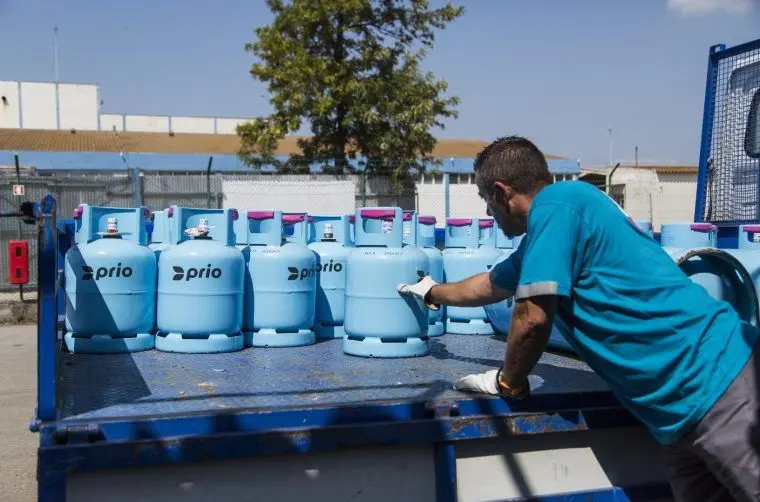How home delivery can go from being a very complicated job to a task of less than 5 minutes
Home distribution (of gas or any other product) is a hard, heavy job with a large customer relationship component. Surely you have wondered if there is a smarter way to manage your daily life while maintaining full control.
On this page, we will explain how Prio Energy not only managed to increase the productivity of its delivery by more than 26%, save more than 25% on delivery costs, or increase customer satisfaction to almost 100%.
But how you too can achieve it.

An operational need
Hundreds of deliveries every day generate stress, errors, service complaints, extra trips and if you add up the staff turnover, you lose all accumulated experience and the security that there would be no problems with deliveries.
You may be familiar with any of these problems. You're not the only one. The first step in solving a problem is to accept that you have a problem and then set goals to solve or minimize those problems.
These are the objectives set by Prio Energy to solve the challenges they faced in home hair distribution:
Business Objectives
- Efficient management of existing resources
- Easy and quick implementation of the tool
- Increased productivity by more than 10%
- Fuel savings and carbon emissions of more than 25%
- Standardization of the operating process
- Increase customer satisfaction
The result of a good process
The most complicated moment of any tool is the start-up. “All” tools achieve the same goal, but the challenge is the energy and time needed to achieve the same result. You can make a fire with 2 stones or a lighter. How long will it take you to achieve your goal?
Prio Energy tested different solutions and Routal Planner was the only solution that led it to deploy the solution into production in less than 24 hours after a single product demonstration.
That was the key to Prio's success. The ease of adopting technology in your route planning team, delivery people and end customer. So easy that if Rui, head of operations, was on vacation, anyone could plan routes with the same level of efficiency and quality of customer service, just as if they were hiring a new delivery person.
Look at the results they got (in just 24 hours):
The story behind the project
Large companies always have the resources to innovate. In its Prio JumpStart program, Prio analyzes the best solutions in the market for the company's different challenges. Long processes of analysis, testing and validation of solutions. They have a lot at stake, any change in a large company is difficult and tedious.
In small companies, they simply test, like and implement the solution in a few days. It all depends on the desire to improve, offer a better service and have greater control over deliveries. Time, technology and investment are no longer critical factors.
The head of operations, Rui, clearly identified some challenges in his operations. For example: route planning could take more than 45 minutes a day, training new delivery people could take weeks or even months if they didn't know the area, as well as a total dependence on the operations manager, with the stress and risk involved, among other challenges they identified.
Innovation always has an associated risk. That's why trial periods exist. Test without obligation if something can work. This is how, after a demonstration to the operations team, the next day they were able to plan routes efficiently, deploy the application to all their distributors and have them begin to confirm deliveries. 1 hour of demonstration and 24 hours later they already had the system working in production without any help. Luck? Perhaps, they simply exported the deliverables of their ERP in Excel format and they were already working.
With a little more time, they began to use advanced functionalities such as the multimodal system (of routes with hazardous materials), communication with customers with which customer satisfaction could be measured and whether the implementation of the tool had improved the service.
The bottom line is that customers had noticed an improvement in service, greater punctuality, greater convenience in delivery and a way to congratulate the delivery people who were doing their job well. Just as in those situations where any problem arose, they could report easily and without filters.
Every innovation project requires validating the results and after more than 5 months in production we were able to analyze the performance in detail. We compared performance in previous years and were able to give assurances that the improvements were very significant. The opinion of the managers and distributors was that there were many other improvements that made their daily lives much easier.
The company, thrilled with the results. Direct savings of 25% of the cost per delivery, more satisfied workers, lower operational risk. In short, a success for all.
Before vs After
Before







After








Results and goals achieved
Routal carried out an exhaustive study on the logistics impact of the operations of one of Prio Energy's distributors. The objective was to measure the real impact of the operations once Planner was implemented, using ROI (return on investment) analysis. The ROI results were conclusive:
- Savings of 25.5% of the cost per delivery (0.86€ savings per delivery)
- Fuel savings of more than 17% (5500 liters of diesel per year)
- Reduction of more than 37,000 km per year
- Savings of more than 194% in tolls (5000€ annual tolls)
- 16% increase in deliveries made (Increase of 2 deliveries per day per vehicle)
- Increased customer satisfaction to 4.93/5
- Reduction of environmental impact by 26.6% (10 tCO2eq per year)
- Standardization of the distribution process
- Reduction of operational risk by the Distribution Manager
- Reducing training time for new drivers
- Optimization and efficient management of existing resources











.png)


